
Historical fairy tales have long histories. These narratives have been told from one generation to the next well before they were ever transcribed. They originated from a variety of cultures, including Eastern traditions. They were initially shared among grown-ups, often carrying themes and messages reflective of the societal norms and beliefs of the time.
Jacob and Wilhelm Grimm, Jacob and Wilhelm, were among the first to assemble many of these beloved narratives. Their collection, "Grimm's Fables," included narratives like "The Story of Cinderella," "Little Brother and Little Sister," and "The True Story of Snow White," which have since become cornerstones in the world of iconic fairy tales. Similarly, Andersen's fanciful narratives, such as "The Story of the Little Mermaid," and "The Little Duckling," have enchanted hearts worldwide, ensuring their place in the pantheon of iconic fairy tales.
Despite their ancient origins, these tales remain as significant as ever, especially as children's night stories. These charming stories are now available in different formats, including richly illustrated books, fantastical animations, and web-based fairy tales.
Their enduring popularity can be ascribed to several fascinating points:
Significant Morals: Old fairy tales often impart important moral lessons. Narratives like "The Tale of the Boy Who Cried Wolf" teach the virtue of being truthful, while "The Tortoise and the Hare" show the values of determination and unassuming nature. These stories offer kids clear distinctions between truth and falsehood, guiding their moral compass in a tender yet deep way.
Empathy and Understanding: Old fairy tales frequently include heroines facing challenges and struggles, provoking listeners to connect with their struggles and boost their triumphs. For instance, "The Tale of Beauty and the Beast" demonstrates the significance of appreciating inner worth to know the inner self of a being, building perception and comprehension.
Cultural Comprehension: Many classic fairy tales are interwoven with the cultural contexts from which they blossomed. Reading these stories can provide illuminating insights into different cultures, nurturing a sense of cultural awareness and awareness.
Imagination and Innovation: The fantasy-filled elements in traditional fairy tales—magical spells—engender children’s innovations. These tales lead readers to supernatural realms, motivating inventive ideas and a sense of magic that persists a lifetime.
Old fairy tales are not only charming but also instructive. They work as mesmerizing tools in nurturing various brain and heart skills in kids. When fairy tales are told out loud, they develop language proficiency by showing new terms and complicated sentence structures. This practice also boosts listening abilities and mindfulness, as young ones stay focused, expectant to see what happens next.
Furthermore, reflecting on the themes and characters of classic fairy tales can improve thought processes and problem-solving abilities. Young ones are educated to pinpoint patterns, forecast, and realize cause and effect. These talks also read more assist the young say their thoughts and feelings, strengthening their emotional intelligence.
In today’s electronic age, the existence of web-based fairy tales has made these tales more within reach than ever. Websites and digital apps share ample collections of children's fairy tales that can be viewed or listened to anytime, anywhere. Fairy tales recited are particularly popular, providing an engaging way for young readers to be a part of these mesmerizing stories. Voice books and read-to-me videos carry characters and settings to life, often accompanied by enchanting background sounds and songs that amplify the tale-telling adventure.
The timeless allure of classic fairy tales lies in their ability to modify to present days while retaining their underlying messages. Contemporary modernizations of these tales often show more varied characters and modern settings, making them accessible to today’s audience. However, the key lessons of heroism, compassion, and fairness remain unchanged, continuing to connect with readers of all ages.
Ancient fairy tales also offer a sense of familiarity and understanding. They offer a systematic narrative with a obvious beginning, middle, and end, often coming to a close with the settlement of conflicts and the triumph of virtue over vice. This regularity can be soothing for the young, proffering a sense of unchangeability in an unpredictable world.
Classic fairy tales continue to mesmerize and coach new generations, maintaining their allure and significance in modern society. As children's bedtime stories, they confer upon a perfect blend of enchantment and education, advancing moral values, empathy, and creativity. The accessibility of free fairy tales online and the popularity of fairy tales recited promise that these ancient stories remain within reach to new generations.
By preserving and divulging these fairy tales, we continue to value the rich tapestry of lore and cultural heritage. Whether you are accessing a colorful picture book, viewing a internet library, or hearing an audio story, the delight of children's fairy tales is always within reach. These tales reveal of the unchanging magic of storytelling and its ability to tie us across generations and cultures.
If you are viewing a vibrantly illustrated book, discovering a online library, or listening to an audiobook, the magic of Grimm's fairy tales is always within reach.
These fairy tales show us of the consistent presence of fairy tales and its ability to hold us together across time and space, forming a connection that fascinates and enlightens alike.